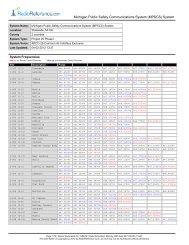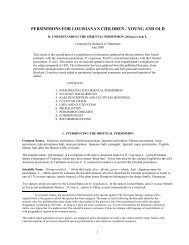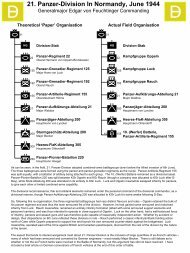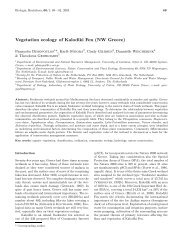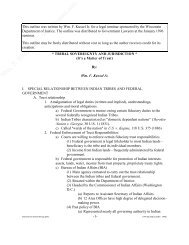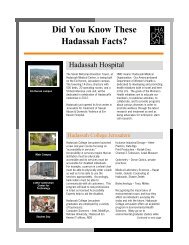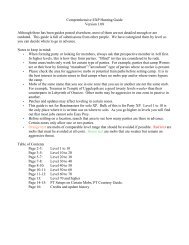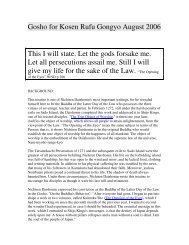Analysis of the Durrand Glacier Avalanche Accident
Analysis of the Durrand Glacier Avalanche Accident
Analysis of the Durrand Glacier Avalanche Accident
Create successful ePaper yourself
Turn your PDF publications into a flip-book with our unique Google optimized e-Paper software.
Executive Summary page 2<br />
The destination chosen for this fatal ski tour first required going down into <strong>the</strong> narrow valley <strong>of</strong><br />
Cairns Creek, and <strong>the</strong>n up to a sub-alpine area called Swiss Meadows. This part <strong>of</strong> <strong>the</strong> route<br />
required crossing potentially high risk and unavoidable avalanche terrain on <strong>the</strong> south face <strong>of</strong><br />
Tumbledown Mountain during a period <strong>of</strong> considerable avalanche hazard. The overall slope <strong>of</strong><br />
this face is about 38° to 40°, which, statistically, is within <strong>the</strong> most common range <strong>of</strong> slope angle<br />
where avalanches occur. An avalanche occurring on this face would carry skiers down over<br />
bluffs or through gullies and into <strong>the</strong> terrain trap at <strong>the</strong> confined bottom <strong>of</strong> <strong>the</strong> Cairns Creek<br />
valley.<br />
From Swiss Meadows, <strong>the</strong> group originally intended to go up low-angled and relatively safe<br />
slopes to <strong>the</strong> summit <strong>of</strong> Fronalp Peak, as shown on Selkirk Mountain Experience’s guiding map.<br />
Instead, <strong>the</strong>y toured up below <strong>the</strong> west ridge <strong>of</strong> Tumbledown Mountain on a route that was so<br />
close to <strong>the</strong> base <strong>of</strong> <strong>the</strong> slope that it was subsequently overrun by <strong>the</strong> avalanches that occurred<br />
later that day.<br />
The La Traviata couloir, where <strong>the</strong> fatal accident occurred, is a steep, wind-loaded, 310 metre<br />
long shallow gully with a 37° upper slope where <strong>the</strong> avalanche started. All <strong>the</strong> avalanche<br />
reference books and o<strong>the</strong>r sources consulted warn that such couloirs have a high probability <strong>of</strong><br />
being potential sites <strong>of</strong> avalanche activity. According to <strong>the</strong> references, <strong>the</strong> specific features <strong>of</strong><br />
this couloir that were indicators <strong>of</strong> high avalanche hazard are:<br />
(a) The slope steepness. <strong>Avalanche</strong> accidents most commonly occur on slopes <strong>of</strong> 31° to 35°;<br />
this one is even steeper at 36° to 37°.<br />
(b) Lee slope build-up and cross-slope loading. Most avalanches occur on slopes where<br />
winds cause snow to accumulate and build up to form dense and potentially dangerous<br />
snow slabs. In this case, more than a metre <strong>of</strong> additional snow was present in <strong>the</strong> gully.<br />
(c) A convex upper slope. At such places <strong>of</strong> convex curvature, a snow slab resting on a<br />
persistent weak layer would be in tension due to <strong>the</strong> difference in <strong>the</strong> rate <strong>of</strong> snow creep<br />
above and below <strong>the</strong> break in slope. A skier crossing over such a convex slope is more<br />
likely to trigger a release compared to o<strong>the</strong>r slopes.<br />
(d) Relatively smooth underlying terrain. This would not provide <strong>the</strong> anchors that a more<br />
coarse, rocky slope would have, and means that <strong>the</strong> slope would have a relatively small<br />
surface roughness depth. Compared to o<strong>the</strong>r areas, this slope would be more prone to<br />
slide with lesser amounts <strong>of</strong> snow.<br />
(e) Connectivity to an area <strong>of</strong> shallow snow. In such areas, <strong>the</strong> weight <strong>of</strong> a person skiing over<br />
into <strong>the</strong> more shallow snow pack can set-<strong>of</strong>f a skier remote triggered avalanche. This is<br />
more likely to happen if <strong>the</strong> snow slab rests on a persistent weak layer, such as a layer <strong>of</strong><br />
faceted crystals, as was <strong>the</strong> case at <strong>Durrand</strong>.<br />
Copyright: no part <strong>of</strong> this report may be reproduced without <strong>the</strong> written permission <strong>of</strong> <strong>the</strong> author.



